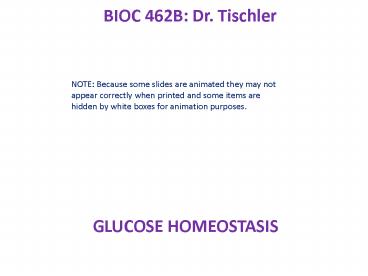BIOC 462B: Dr' Tischler PowerPoint PPT Presentation
1 / 13
Title: BIOC 462B: Dr' Tischler
1
BIOC 462B Dr. Tischler
NOTE Because some slides are animated they may
not appear correctly when printed and some items
are hidden by white boxes for animation purposes.
GLUCOSE HOMEOSTASIS
2
- Objectives
- Identify the sources of blood glucose and the
major fuel for the brain in the absorptive,
postabsorptive, starvation and prolonged
starvation states. - Discuss how ketoacidosis (ketosis) is normally
prevented in prolonged starvation. - Discuss the role of the glucose/fatty acid/ketone
body cycle in starvation. - Discuss the roles of insulin, glucagon and
cortisol in the pattern of changes in the major
source(s) of fuel during the transition from the
well-fed state to prolonged starvation. - Describe how fatty acids help maintain blood
glucose homeostasis in starvation.
3
OVERVIEW OF SYSTEMS OF ENERGY METABOLISM
GLYCOGEN
TRIACYLGLYCEROLS
PROTEIN
Amino Acids
Glucose-6-P
Glucose
Free Fatty Acids
Lactate
Acetyl-CoA
Pyruvate
Ketone Bodies
CO2, H2O
ATP
4
BLOOD GLUCOSE HOMEOSTASIS
- hyperglycemia too little insulin
- hypoglycemia too little intake or too much
insulin
5
Table 1 - Phases of glucose homeostasis
6
fed postabsorptive gluconeogenic
prolonged I II
III
IV
40 30 20 10 0
Exogenous (glucose from diet)
glucose from gluconeogenesis (lactate amino
acids)
Glucose Used g/hr
glucose from gluconeogenesis (mostly lactate)
glucose from liver glycogen
4 8 12 16 2
7 42
HOURS
DAYS
Figure 1. Sources of blood glucose in the
various nutritional states
7
Fuel Source ()
Well-fed state
Early Starvation 1- 5 days
Prolonged Starvation 7 days
NUTRITIONAL STATUS
Postabsorptive State 4-24 h
Figure 2. Changes in the major source of fuel
during the transition from well-fed state to
prolonged starvation.
8
REVIEW
?-HBDH ?-hydroxybutyrate dehydrogenase
9
Figure 3. Mechanism for prevention of
ketoacidosis from excess ketone body production
10
Figure 4. The glucose\fatty acid cycle well
fed state
ADIPOSE TISSUE
BRAIN
CO2
Pyruvate
TG
insulin
GLC
3
FA
Glucose
insulin
PANCREAS
BLOOD
GLUCOSE (diet)
FATTY ACIDS (diet)
GLC
Insulin
insulin
KETONE BODIES
GLC
CO2
MUSCLE
LIVER
11
GLUCOSE UTILIZATION
Figure 5. Metabolic adaptation during the
gluconeogenic (early starvation) phase.
12
Figure 6. The glucose\fatty acid\ketone body
cycle starvation
ADIPOSE TISSUE
BRAIN
CO2
TG
X
GLC
FA
PANCREAS
BLOOD
GLUCOSE
Insulin
FATTY ACIDS
MUSCLE
KETONE BODIES
GLC
FA
X
CO2
LIVER
13
BLOOD GLUCOSE HOMEOSTASIS
Figure 7. Metabolic adaptation to prolonged
starvation. ? indicates increase and ? indicates
decrease of the process.

